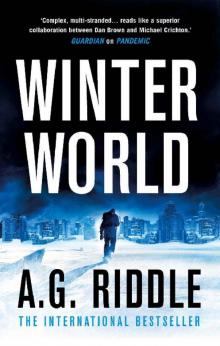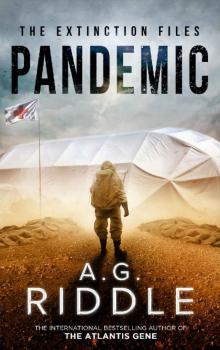- Home
- A. G. Riddle
Pandemic (The Extinction Files Book 1) Page 5
Pandemic (The Extinction Files Book 1) Read online
Page 5
“Yes.”
“Wonderful, wonderful. Listen, I’m in Berlin for business, and I could really use some help. I took the train in and when I woke up it was all gone—I mean everything: my luggage, laptop, wallet, passport, money, credit cards, you name it, gone. The rascals even slipped my wedding ring off!”
“Oh, that’s terrible,” the woman said with a little more sympathy.
“My wife wired me some money, and I’m looking for a place to rent. Can we meet? You’ll see I’ve got an honest face!” Desmond let out a goofy, nervous laugh that matched the fake exasperated accent he had affected.
“Ah, well, okay.” The woman said it would be three hours before she could get to the flat. Desmond agreed and ended the call. Assuming it worked out, he’d be off the street soon.
He opened a web browser and scanned the top German news sources. Bild carried no news about him, but a breaking news banner at the top of Spiegel Online read: Berlin police launch citywide manhunt for American man wanted for murder and assaulting two police officers.
Desmond clicked the link and scanned the article. The hunt was being run by the Landeskriminalamt, also known as the LKA—the police division charged with investigating major crimes and conducting special manhunts. The LKA would be coordinating a number of units. Reading the list gave Desmond pause about staying in the city.
The Spezialeinsatzkommando—the state police’s SWAT teams—were on standby for locations to raid. Mobiles Einsatzkommando—the special operative agents of the LKA—were being deployed to every borough to conduct a manhunt. Wasserschutzpolizei—the river police—were monitoring all the city’s waterways. Zentraler Verkehrsdienst—the traffic police—had engaged local and highway patrol units (Autobahnpolizei) to search for him. They even had Diensthundführer—K9 units—at the Concord, picking up his scent.
They were about to turn the city upside down looking for him.
Despite naming him, the article didn’t have any details about who he was or his background. This was both a relief and a disappointment. It would make it harder for them to find him—but it told him nothing about who he was.
Desmond opened the phone’s map application and found what he needed. Despite the citywide manhunt launching, Wedding looked like it would be a perfect place to hide. But Desmond still had the sense that he was missing something—and that the dry cleaner was somehow part of the puzzle.
Three blocks away, Desmond sat in the changing room of a secondhand thrift shop. Two outfits hung on the inside of the door, both Turkish-made and more casual than his button-up shirt and khakis.
When he slipped his pants off, what he saw took his breath away. Burn scars spread from his feet to his knees. The mottled flesh looked like creamy-white tree roots growing across his body. They were old scars, remnants of a horrible event. The feeling was unnerving—not being able to remember the fire that had torched his legs. He searched the rest of his body. Above his pelvis on the right side, he found a puckered, rounded scar below his ribs. A healed gunshot wound? Scattered about his torso and arms were smaller, straight scars where knife wounds had likely healed. In the hotel room, he had been so focused on the aching black and blue bruise on his left side that he hadn’t noticed anything else. Now he longed to know where he’d come from, what sort of life he’d led—what sort of person he was. Or at least, had been.
As he stared at the floor, something inside the crumpled-up khaki pants caught his eye: a pink tag stapled to the garment’s care instructions. He had seen similar tags before, only hours ago, attached to clear plastic bags hanging in rows… in the dry cleaner.
He had found the claim tag.
He detached it, then carefully searched both the shirt and pants, finding nothing else of interest. He sold the shirt and pants to the thrift shop—he needed the money, and police across the city likely had pictures of him wearing them by now. A sign on the wall claimed all items were thoroughly cleaned before being offered for sale, and he hoped it was true; if not, the police dogs might pick up the scent in the store. With some of his extra money he purchased a ball cap, sunglasses, and a backpack. In the changing room, he put all his possessions—the extra clothes and the spare magazines for the policeman’s gun—in the backpack.
Ten minutes later, he once again stood outside the dry cleaner. The older Asian man was gone; a younger man, also Asian, now sat at the counter, hunched over a textbook, a pencil in his hand, scribbling notes.
Desmond walked in and slid him the tag without a word.
The teenager searched the rows of hanging clothes, checking the tag several times. After a few minutes he shook his head and returned to the counter.
“You’re picking up late. There’s a fee.”
“How much?”
“Three euros per day.”
“How late am I?”
Desmond was already dangerously low on cash; he had just enough to pay the rent at the crummy flat for three days, and he was due to meet the landlord in less than an hour.
The teen worked the computer, searching the tag number. “Fourteen days late. Forty-two euros plus the cleaning. Fifty-five total with tax.”
If he paid, Desmond wouldn’t have enough for rent for all three nights. He considered pulling the police ID again, but that would only invite problems. So he forked the cash over and waited while the teen thrashed around in the back for what felt like an hour. Desmond hoped it would be worth it—that whatever he, or someone, had stashed here contained something to get him out of the fix he was in.
The boy emerged with a plastic hanging bag covering an expensive-looking navy suit. Desmond could barely resist the urge to tear it open and examine it right there. His appointment with the landlord, however, was fast approaching, so with the suit hanging over his shoulder, he made his way to the meeting spot.
He found a young woman in her mid-twenties, a cigarette in her hand, standing in front of a run-down three-story building. Four Middle Eastern teenagers sat on the steps outside the front door, arguing in a language Desmond didn’t recognize.
“Are you Ingrid?” he asked in the same New England accent he had used before.
“Ja.” She put the cigarette out and accepted Desmond’s hand when he extended it eagerly.
“I’m Peter Wilkinson. We spoke earlier. Thank you so much for meeting me on such short notice.”
She led him inside, up a winding, narrow staircase, and into the flat, which was tiny but clean.
“It’s perfect,” Desmond said. “Now listen, this suit is literally all they left me with. Guess they didn’t know it was mine!” He smiled sheepishly. “I need it for my meeting tomorrow, and,” he sighed, “I’m running low on cash.”
The woman shook her head. “If you can’t pay, you simply cannot stay here.”
“I’ve got enough for one night.” He handed her the folded-up euros. “I’ll get you the rest.”
Ingrid hesitated.
“Look, if I can’t pay tomorrow, I’ll leave. Promise. My wife is going to wire me some more money. I promise. Okay?”
Ingrid glanced away from him. “All right. I’ll come back tomorrow with my boyfriend. Please pay or be gone.”
“No problem. Thank you again.”
The moment the door closed, Desmond ripped into the plastic dry cleaning bag and searched the suit. The patch inside the jacket listed the maker as Richard Anderson, 13 Savile Row. He wondered if it was another clue. He ran his fingers over the embroidery—and felt a lump.
His heart beat faster. There was something sewn inside the suit.
Chapter 7
At CDC headquarters in Atlanta, Peyton was working on the central mystery in the outbreak in Mandera: the patients. She believed she had just made a breakthrough.
The two young Americans had started a nonprofit organization called CityForge. Its mission was to help villages grow by giving them funding for infrastructure and mentoring from city leaders in the developed world. CityForge’s funding came from individuals, who donated vi
a the CityForge website. The investments were treated as municipal bonds, which meant the donors would benefit financially if the villages thrived. Villages used the money to bring electricity, education, better roads, health care, internet, public sanitation, police enforcement, and other vital services to their citizens.
As part of the CityForge model, local leaders were trained to film the village’s gradual transformation. The videos gave the mentors in the developed world a way to follow the progress of the villages. In almost real time, city council leaders, mayors, police chiefs, and others could see the villages change, and could offer guidance. Individual donors could also follow the villages’ progress, like a reality show, seeing how the money they provided was improving the lives of the current residents and laying the groundwork for generations to come.
The CityForge founders had come up with the idea while they were undergraduates at UNC-Chapel Hill, and after graduating this past May, they had set out to make their concept a reality. They had spent the summer promoting their startup and raising money from friends, family, and passionate supporters. They used the funds for their trip to Kenya, where they planned to document every stop along the way—and identify their first “CityForge villages.” And, for reasons that remained unclear to Peyton, the two boys had made a pact not to shave or cut their hair during the trip.
She clicked the Supporters page and read the names. Icarus Capital was among the corporate sponsors. She had seen the name before—hours ago, in her apartment. It was Desmond Hughes’s investment firm. Was he involved in some way? She thought it was an odd coincidence, but she couldn’t think of a way to act on the connection.
Even thinking about Desmond rattled her. She fought to stay focused.
Another tab on the CityForge site featured a map with every stop the two young men had made. Most included one or more videos of the two Americans touring the village and doing interviews with residents. Mostly, they highlighted how infrastructure could change the villagers’ lives. For a few of the villages, the videos continued after the two Americans had left. The more recent films had been uploaded by village leaders hoping to attract financial supporters.
The trip log was a dream for an epidemiologist. Peyton wondered if one of the videos would show the origin of the outbreak. She might even be able to track its spread.
The key to stopping an outbreak was containment. The first step in containment was to isolate anyone who was infected, and the second step was to interview all the infected patients and develop a list of every person they had come into contact with—a process called contact tracing. From those contacts, Peyton and her team would begin a repeating process. They would search for contacts. If the contact was sick, they would isolate them and trace anyone they had come into contact with; if the contact was asymptomatic, they would test them for the disease and typically quarantine them until Peyton and her team could be sure the person was infection-free. For Ebola, that quarantine period was twenty-one days. Eventually, when they had no new contacts to trace, they would end up with two groups: infected and quarantined.
But contact lists grew quickly. With each passing hour, a pathogen would reach more and more people. Time was of the essence; in most cases, the first few days of an outbreak determined everything after.
On a pad, Peyton had written the names of the two Americans, Steven Cobb and Lucas Turner, as well as the British patient, Andrew Blair. Between them, she had drawn a large X. The X was the variable, the unknown—what she needed to find. At some point, the British man had interacted with one or both of the Americans. Either that, or all three had a common contact—someone still out there, continuing to spread the disease. It was imperative that she find out where each of them had been and whom they had interacted with. The travel log could be the key to doing that.
If Peyton and her team did their job correctly, they’d end up with a contact tree that eventually had a root contact: the first person to contract the disease, often called patient zero or the index case.
That was the on-the-ground detective work: tracing the pathogen to its origin, containing every person it had touched, and either treating the patients or simply waiting for the outbreak to burn itself out.
But even with the video travel log, Peyton and her team were going to need a lot of help in Kenya.
She picked up her office phone and called Joseph Ruto, head of the CDC’s office in Kenya. Ruto was just finishing a late lunch in Nairobi, which was eight hours ahead of Atlanta.
She briefed him on their plans, with the caveat that they might change after the morning conference. The man struck her as competent and focused, and she counted that as a very good sign.
It was just before six a.m. when she hung up. She had been waiting to make the next call; she wanted her people to get as much rest as possible. Sleep might be hard to come by in the coming days.
She dialed the EOC’s head of watch and requested they contact all of the Epidemiology Intelligence Service agents.
“All of them?” the watch officer asked.
“Everyone assigned to CDC HQ. Instruct them to be in the building by seven a.m. for a pre-conference briefing. They need to come packed and prepared to leave in a few hours. If they’re deployed, they’ll be working either in Nairobi or in the field in rural Kenya. Instruct them to plan accordingly.”
“Understood, Dr. Shaw.”
The EIS program was a two-year fellowship established at the CDC in 1951. It had begun as a Cold War initiative focused on bioterror. Today it was one of the most prestigious and sought-after fellowships in applied epidemiology, known for producing the world’s best disease detectives. Candidates applying to the program needed to be either a physician with at least a year of clinical experience, a veterinarian, a PhD-level scientist with a background in public health, or a health care professional with at least a masters degree in public health. There were currently 160 EIS officers, seventy percent of whom were women.
During their fellowship, EIS officers often worked in the field, on the front lines of outbreaks. During the 2014 Ebola outbreak, every one of the 158 EIS officers deployed. They served in seventeen countries, eight states, Washington, DC, and the CDC’s Emergency Operations Center. During that time, they collectively contributed 6,903 days of service—almost nineteen years combined. Peyton hoped for everyone’s sake that the current outbreak would be concluded much more quickly.
Peyton was the CDC’s leading field epidemiologist, and she was also an EIS instructor. She took both jobs very seriously. The EIS officers she was training could well be making the calls during the next major outbreak or leading the first response at the state level or overseas. Alumni from the program included the current CDC director, past and current acting surgeon generals, branch and division leaders across the CDC, and state and local epidemiologists across the country.
She hadn’t had a chance to work with every fellow in the current class, and this might be a good opportunity. She began browsing through the personnel files, assembling her team.
At seven a.m., Peyton stood at the podium in Auditorium A of Building 19 on the CDC campus. A fourth of the EIS officers were deployed at local and state health offices; they had dialed in to the presentation. The officers who worked at CDC HQ were assembled in the room. One hundred and twenty faces stared down at Peyton.
“Good morning. I’m about to brief you on an outbreak of what we believe is a viral hemorrhagic fever in a small town in Kenya. Pay close attention. Some of you will be deployed today; we’ll fly to Kenya this afternoon. Others will support our field operations from CDC HQ, for now. Depending on how things go, some of you may end up deployed to the field at a later date. Take notes, ask questions, and learn all you can. Your lives may depend on it. And so could someone else’s.
“Okay. Here’s what we know so far…”
Chapter 8
At eight a.m., the EOC’s conference room was overflowing. Employees from several CDC divisions as well as representatives from the State D
epartment and the US Agency for International Development (USAID) were on hand.
Peyton sat at the table next to Elliott Shapiro. The EIS agents she’d selected for the deployment were in Auditorium A, watching the conference on a projection screen.
After introductions, Elliott led a briefing on the current situation. The State Department representative, Derek Richards, spoke next.
“From our perspective, this is an outbreak in the worst possible place at the worst possible time. Let’s start with some background.”
Richards clicked his mouse, and an image of a badly burned building appeared.
“August, 1998. Truck bombs exploded outside the US embassies in Nairobi, Kenya, and Dar es Salaam, Tanzania. In Nairobi, 213 people died. Four thousand were injured. The attack was linked to al-Qaeda. In fact, it’s what caused the FBI to put bin Laden on the ten-most-wanted list for the first time. Less than two weeks later, the Clinton administration launched cruise missiles at Sudan and Afghanistan in Operation Infinite Reach. The hit on bin Laden failed. In response, the Taliban renewed their commitment to harbor him, and the rest is history.
“State decided not to rebuild the embassy that was bombed in Nairobi. We built a new embassy directly across the street from the UN for security purposes.
“In the years since the Nairobi bombing, the security situation in Kenya has gotten worse. Crime is high everywhere in the country. It’s particularly bad in the larger cities: Nairobi, Mombasa, Kisumu, and the coastal resorts. In Nairobi alone, there are ten carjackings every day. In May 2014, the US, UK, France, and Australia began issuing travel warnings to their citizens in Kenya. The US went further, reducing our staff at the Nairobi embassy. The UK closed their consulate in Mombasa. The effects of the travel advisories were devastating to the Kenyan tourism industry. European travel to the country ground to a halt.
“Our main concern, however, is al-Shabaab. They’re an Islamic terror group based in Somalia, with cells and operatives throughout Kenya. They want to turn Somalia into a fundamentalist Islamic state. They’re essentially ISIS in East Africa. They’re brutal, organized, and relentless. The African Union has deployed twenty-two thousand troops to Somalia to try to contain them. They’re losing.”

 The Atlantis Gene: A Thriller
The Atlantis Gene: A Thriller The Solar War (The Long Winter Book 2)
The Solar War (The Long Winter Book 2) The Extinction Files Box Set
The Extinction Files Box Set The Atlantis Trilogy Box Set- The Complete Series
The Atlantis Trilogy Box Set- The Complete Series Winter World
Winter World Genome
Genome Pandemic (The Extinction Files Book 1)
Pandemic (The Extinction Files Book 1) The Atlantis Gene: A Thriller (The Origin Mystery, Book 1)
The Atlantis Gene: A Thriller (The Origin Mystery, Book 1) Departure
Departure Genome (The Extinction Files Book 2)
Genome (The Extinction Files Book 2) The Atlantis World (The Origin Mystery, Book 3)
The Atlantis World (The Origin Mystery, Book 3) The Atlantis Plague: A Thriller (The Origin Mystery, Book 2)
The Atlantis Plague: A Thriller (The Origin Mystery, Book 2)